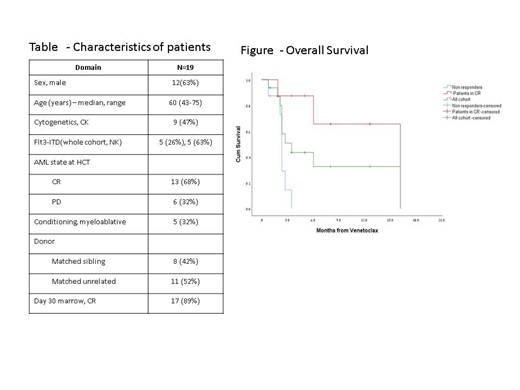Introduction: Prognosis in patients with post allogeneic HCT-early relapse of AML is dismal and response to salvage treatment is less than 20%. Venetoclax has been shown to be safe and efficacious in frail/elderly patients with AML. Treatment results in an increase of pro-apoptotic function, thus the addition of alloreactive T cells may augment the anti-leukemic potency. We hypothesized that the combination of donor lymphocyte infusion may further enhance this response. Methods: Eligibility criteria for this protocol were - age>18 y, early (<6 months post allogeneic HCT) relapse and no concurrent GVHD. Venetoclax was administered at a daily dose of 400 mg for up to 6 cycles with DLI in escalating doses for up to 4 doses. Additional chemotherapy was allowed according to physician discretion. Primary endpoint of study included assessment Overall response (CR/CRi/CRp) rate at 3 months post treatment. Secondary endpoints included 1-year OS, rate of acute and chronic GVHD, documented infections, hematological complications, and other safety measures. Results: From January 2017 until May 2019, 19 patients were given the study protocol. Median age was 60 (43-75) years, Table. There were no cases of tumor lysis syndrome. Microbiology documented infections occurred in 5 patients (26%) and 2 patients were admitted during protocol (10%). No cases of significant bleeding were observed, and majority of patients were able to tolerate the protocol without any admissions. Acute GVHD was observed in 2 (10%) patients and chronic GVHD was observed in 4 (21%) patients. Overall response was observed in 8 (47%) patients (CR, n=3; CRi, n=2; CRp, n=3). Median time to response was 28 (18-67) days (median number of courses 2 (1-6)) and duration of response was 106 (31-395) days. Survival at 6 months was 3.5 months (95% CI 1.5-5.5). Median survival of patients achieving complete remission was 16.2 months (CI not det.), Figure. On univariate analysis there was no association between patients and disease's characteristics and overall survival, however any type of GVHD (entered to the model as a time dependent variable) was associated with a lower rate of mortality (HR=0.2, p= .03). Conclusions: These results may endorse the hypothesis that enhancing alloreactivity as a therapy may lead to a chemotherapy free approach to relapsed AML. A phase 2 study is under preparation with a larger sample size and a standardized approach to additional salvage chemotherapy added versus Venetoclax + DLI regimen only for a more robust analysis of this therapeutic approach.
No relevant conflicts of interest to declare.
Author notes
Asterisk with author names denotes non-ASH members.


This feature is available to Subscribers Only
Sign In or Create an Account Close Modal